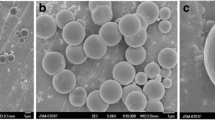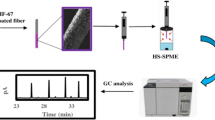Abstract
In this work, a zeolitic imidazolate framework-based graphene oxide composite (ZIF-8@GO) was prepared and used as the adsorbent in hollow fiber stir bar sorptive extraction. The stir bar was constructed of a small section of hollow fiber filled with 5 mg ZIF-8@GO and a thin stainless wire of 1.5 cm long in its lumen, and used to extract the trace levels of phthalate esters from children’s food samples prior to gas chromatography–mass spectrometric detection. The ZIF-8@GO showed a high adsorption efficiency for the compounds containing aromatic rings. The main experimental parameters that can impact the extraction efficiency including extraction temperature, extraction time, stirring rate, sample salinity, and desorption conditions were investigated. Under the optimized conditions, the limits of detection (LODs) for the five phthalate esters (diethyl phthalate, dipropyl phthalate, diisobutyl phthalate, butylbenzyl phthalate, and di(2-ethylhexyl) phthalate) were 0.15–0.6 µg L−1 for CiCi beverage and pear juice samples, and 0.75–2.2 µg kg−1 for jam samples. The limits of quantitation (LOQs) were 0.5–2.0 µg L−1 for CiCi beverage and pear juice samples, and 2.5–7.5 µg kg−1 for jam samples. Wide linear ranges of 0.5–500.0 µg L−1 and 2.5–2000 µg kg−1 were obtained for CiCi beverage, pear juice samples and jam samples, respectively, with good repeatability (RSD < 11%) and high method recoveries (72%–100%). The lifetime test results showed that the ZIF-8@GO-based hollow fiber stir bar can be reused for 120 extraction cycles without a significant loss of extraction efficiency, indicating its high durability and stability. The established method was applied successfully for the determination of the phthalate esters (PAEs) in children’s food samples.
Graphical abstract





Similar content being viewed by others
References
Zhao HM, Du H, Xiang L, Chen YL, Lu LA, Li YW, Li H, Cai QY, Mo CH (2015) Variations in phthalate ester (PAE) accumulation and their formation mechanism in Chinese flowering cabbage (Brassica parachinensis L.) cultivars grown on PAE-contaminated soils. Environ Pollut 206:95–103
Meng XZ, Wang Y, Xiang N, Chen L, Liu Z, Wu B, Dai X, Zhang YH, Xie Z, Ebinghaus R (2014) Flow of sewage sludge-borne phthalate esters (PAEs) from human release to human intake: implication for risk assessment of sludge applied to soil. Sci Total Environ 476–477:242–249
Tsai HJ, Chen BH, Wu CF, Wang SL, Huang PC, Tsai YC, Chen ML, Ho CK, Hsiung CA, Wu MT (2016) Intake of phthalate-tainted foods and microalbuminuria in children: The 2011 Taiwan food scandal. Environ Int 89–90:129–137
Hallmark N, Walker M, McKinnell C, Mahood IK, Scott H, Bayne R, Coutts S, Anderson RA, Greig I, Morris K, Sharpe RM (2007) Effects of monobutyl and di(n-butyl) phthalate in vitro on steroidogenesis and leydig cell aggregation in fetal testis explants from the rat: comparison with effects in vivo in the fetal rat and neonatal marmoset and in vitro in the human. Environ Health Persp 115(3):390–396
Alatriste-Mondragon F, Iranpour R, Ahring BK (2003) Toxicity of di-(2-ethylhexyl) phthalate on the anaerobic digestion of wastewater sludge. Water Res 37(6):1260–1269
Latini G, Wittassek M, Del Vecchio A, Presta G, De Felice C, Angerer J (2009) Lactational exposure to phthalates in Southern Italy. Environ Int 35(2):236–239
Olujimi OO, Fatoki OS, Odendaal JP, Okonkwo JO (2010) Endocrine disrupting chemicals (phenol and phthalates) in the South African environment: a need for more monitoring. Water SA 36(671–682):671–682
Cao XL (2010) Phthalate esters in foods: sources, occurrence, and analytical methods. Compr Rev Food Sci F 9(1):21–43
Luo YB, Yu QW, Yuan BF, Feng YQ (2012) Fast microextraction of phthalate acid esters from beverage, environmental water and perfume samples by magnetic multi-walled carbon nanotubes. Talanta 90:123–131
Ren R, Jin Q, He HL, Bian TB, Wang ST, Fan JC (2016) Determination of 17 phthalate esters in infant milk powder and dairy products by GC-MS with 16 internal standards. Chromatographia 79(13–14):903–910
Xu M, Liu M, Sun M, Chen K, Cao X, Hu Y (2016) Magnetic solid-phase extraction of phthalate esters (PAEs) in apparel textile by core-shell structured Fe3O4@silica@triblock-copolymer magnetic microspheres. Talanta 150:125–134
Liu X, Sun Z, Chen G, Zhang W, Cai Y, Kong R, Wang X, Suo Y, You J (2015) Determination of phthalate esters in environmental water by magnetic zeolitic imidazolate framework-8 solid-phase extraction coupled with high-performance liquid chromatography. J Chromatogr A 1409:46–52
Liu D, Min S, Ping H, Song X (2016) The application of directly suspended droplet microextraction for the evaluation of phthalic acid esters in cow’s milk by gas chromatography mass spectrometry. J Chromatogr A 1443:66–74
Ye CW, Gao J, Yang C, Liu XJ, Li XJ, Pan SY (2009) Development and application of an SPME/GC method for the determination of trace phthalates in beer using a calix[6]arene fiber. Anal Chim Acta 641(1–2):64–74
Wang FQ, Li J, Wu JF, Zhao GC (2018) Layered double hydroxides as a coating for the determination of phthalate esters in aqueous solution with solid-phase microextraction followed by gas chromatography. Chromatographia 81(5):799–807
Pérez-Outeiral J, Millán E, Garcia-Arrona R (2016) Determination of phthalates in food simulants and liquid samples using ultrasound-assisted dispersive liquid–liquid microextraction followed by solidification of floating organic drop. Food Control 62:171–177
Wang J, Huang S, Wang P, Yang Y (2016) Method development for the analysis of phthalate esters in tea beverages by ionic liquid hollow fibre liquid-phase microextraction and liquid chromatographic detection. Food Control 67:278–284
Liang P, Li Q, Xu J, Du D (2008) LC determination of phthalate esters in water samples using continuous-flow microextraction. Chromatographia 68(5–6):393–397
Li J, Qi HY, Wang YB, Su Q, Wu S, Wu L (2016) Hollow fiber-stir bar sorptive extraction and microwave assisted derivatization of amino acids in biological matrices. J Chromatogr A 1474:32–39
Boontongto T, Siriwong K, Burakham R (2018) Amine-functionalized metal-organic framework as a new sorbent for vortex-assisted dispersive micro-solid phase extraction of phenol residues in water samples prior to HPLC analysis: experimental and computational studies. Chromatographia 81(5):735–747
Jia G, Gao Y, Zhang W, Wang H, Cao Z, Li C, Liu J (2013) Metal-organic frameworks as heterogeneous catalysts for electrocatalytic oxidative carbonylation of methanol to dimethyl carbonate. Electrochem Commun 34:211–214
Herm ZR, Bloch ED, Long JR (2014) Hydrocarbon separations in metal-organic frameworks. Chem Mater 26(1):323–338
Kumar P, Kumar P, Bharadwaj LM, Paul AK, Deep A (2014) Luminescent nanocrystal metal organic framework based biosensor for molecular recognition. Inorg Chem Commun 43:114–117
Furukawa H, Ko N, Go YB, Aratani N, Choi SB, Choi E, Yazaydin AO, Snurr RQ, O’Keeffe M, Kim J, Yaghi OM (2010) Ultrahigh porosity in metal-organic frameworks. Science 329(5990):424–428
Hafizovic J, Bjørgen M, Olsbye U, Dietzel PDC, Bordiga S, Prestipino C, Lamberti C, Lillerud KP (2007) The inconsistency in adsorption properties and powder XRD data of MOF-5 is rationalized by framework interpenetration and the presence of organic and inorganic species in the nanocavities. J Am Chem Soc 129(12):3612–3620
Wang S, Wang X, Ren Y, Xu H (2015) Metal-organic framework 199 film as a novel adsorbent of thin-film extraction. Chromatographia 78(9–10):621–629
Petit C, Bandosz TJ (2010) Enhanced adsorption of ammonia on metal-organic framework/graphite oxide composites: analysis of surface interactions. Adv Funct Mater 20(1):111–118
Reboul J, Furukawa S, Horike N, Tsotsalas M, Hirai K, Uehara H, Kondo M, Louvain N, Sakata O, Kitagawa S (2012) Mesoscopic architectures of porous coordination polymers fabricated by pseudomorphic replication. Nat Mater 11(8):717–723
Levasseur B, Petit C, Bandosz TJ (2010) Reactive adsorption of NO2 on copper-based metal-organic framework and graphite oxide/metal-organic framework composites. ACS Appl Mater Interfaces 2(12):3606–3613
Petit C, Burress J, Bandosz TJ (2011) The synthesis and characterization of copper-based metal-organic framework/graphite oxide composites. Carbon 49(2):563–572
Petit C, Bandosz TJ (2011) Synthesis, characterization, and ammonia adsorption properties of mesoporous metal-organic framework (MIL(Fe))-graphite oxide composites: exploring the limits of materials fabrication. Adv Funct Mater 21(11):2108–2117
Petit C, Huang L, Jagiello J, Kenvin J, Gubbins KE, Bandosz TJ (2011) Toward understanding reactive adsorption of ammonia on Cu-MOF/graphite oxide nanocomposites. Langmuir 27(21):13043–13051
Petit C, Bandosz TJ (2009) MOF-graphite oxide composites: combining the uniqueness of graphene layers and metal-organic frameworks. Adv Mater 21(46):4753–4757
Hasan Z, Jhung SH (2015) Removal of hazardous organics from water using metal-organic frameworks (MOFs): plausible mechanisms for selective adsorptions. J Hazard Mater 283:329–339
Kumar R, Jayaramulu K, Maji TK, Rao CN (2013) Hybrid nanocomposites of ZIF-8 with graphene oxide exhibiting tunable morphology, significant CO2 uptake and other novel properties. Chem Commun (Camb) 49(43):4947–4949
Xie Z, He Z, Feng X, Xu W, Cui X, Zhang J, Yan C, Carreon MA, Liu Z, Wang Y (2016) Hierarchical sandwich-like structure of ultrafine N-rich porous carbon nanospheres grown on graphene sheets as superior lithium-ion battery anodes. ACS Appl Mater Interfaces 8(16):10324–10333
Wang C, Feng C, Gao Y, Ma X, Wu Q, Wang Z (2011) Preparation of a graphene-based magnetic nanocomposite for the removal of an organic dye from aqueous solution. Chem Eng J 173(1):92–97
Guo ZY, Wei DY, Wang ML, Wang S (2010) Determination of six phthalic acid esters in orange juice packaged by PVC bottle using SPE and HPLC-UV: application to the migration study. J Chromatogr Sci 48(9):760–765
Yan H, Cheng X, Yan K (2012) Rapid screening of five phthalate esters from beverages by ultrasound-assisted surfactant-enhanced emulsification microextraction coupled with gas chromatography. Analyst 137(20):4860–4866
Zhang S, Niu H, Cai Y, Shi Y (2010) Barium alginate caged Fe3O4@C18 magnetic nanoparticles for the pre-concentration of polycyclic aromatic hydrocarbons and phthalate esters from environmental water samples. Anal Chim Acta 665(2):167–175
Yao J, Xu H, Lv L, Song D, Cui Y, Zhang T, Feng YQ (2008) A novel liquid-phase microextraction method combined with high performance liquid chromatography for analysis of phthalate esters in landfill leachates. Anal Chim Acta 616(1):42–48
Zhang S, Li Z, Yang X, Wang C, Wang Z (2015) Fabrication of a three-dimensional graphene coating for solid-phase microextraction of polycyclic aromatic hydrocarbons. RSC Adv 5(67):54329–54337
Fan J, Dong Z, Qi M, Fu R, Qu L (2013) Monolithic graphene fibers for solid-phase microextraction. J Chromatogr A 1320:27–32
Acknowledgements
Financial supports from the Natural Science Foundation of Hebei Agricultural University (LG201810), the Natural Science Foundation of Hebei Province (C2018204076), and the Youth Scientific and Technological Research Foundation of the Department of Education of Hebei for Hebei Provincial Universities (QN2017085) are gratefully acknowledged.
Author information
Authors and Affiliations
Corresponding author
Ethics declarations
Conflict of interest
All authors declare that they have no conflict of interest.
Ethical approval
This article does not contain any studies with human participants or animals performed by any of the authors.
Additional information
Publisher’s Note
Springer Nature remains neutral with regard to jurisdictional claims in published maps and institutional affiliations.
Electronic supplementary material
Below is the link to the electronic supplementary material.
Rights and permissions
About this article
Cite this article
Shen, C., Wu, T. & Zang, X. Hollow Fiber Stir Bar Sorptive Extraction Combined with GC–MS for the Determination of Phthalate Esters from Children’s Food. Chromatographia 82, 683–693 (2019). https://doi.org/10.1007/s10337-018-3679-x
Received:
Revised:
Accepted:
Published:
Issue Date:
DOI: https://doi.org/10.1007/s10337-018-3679-x




